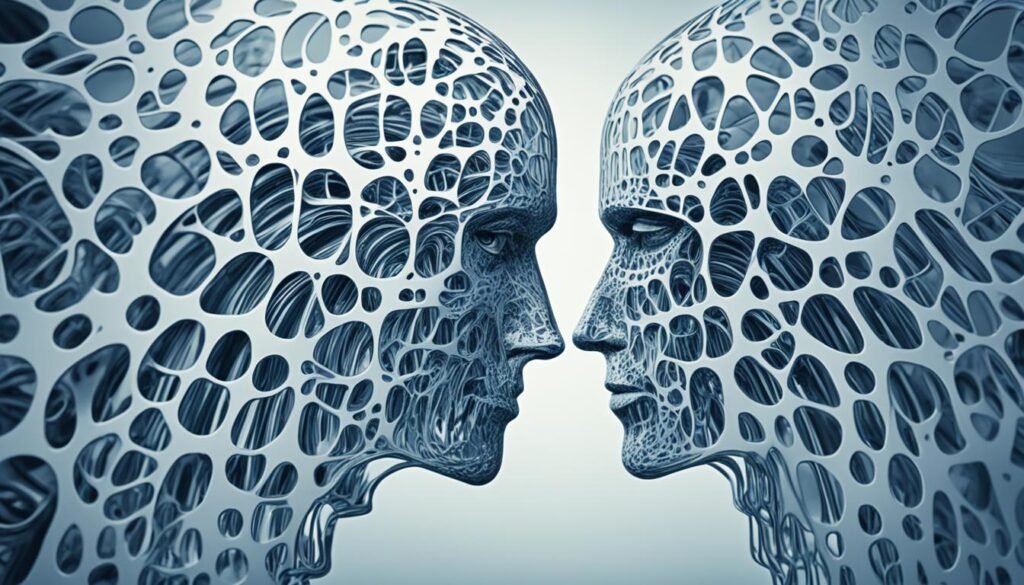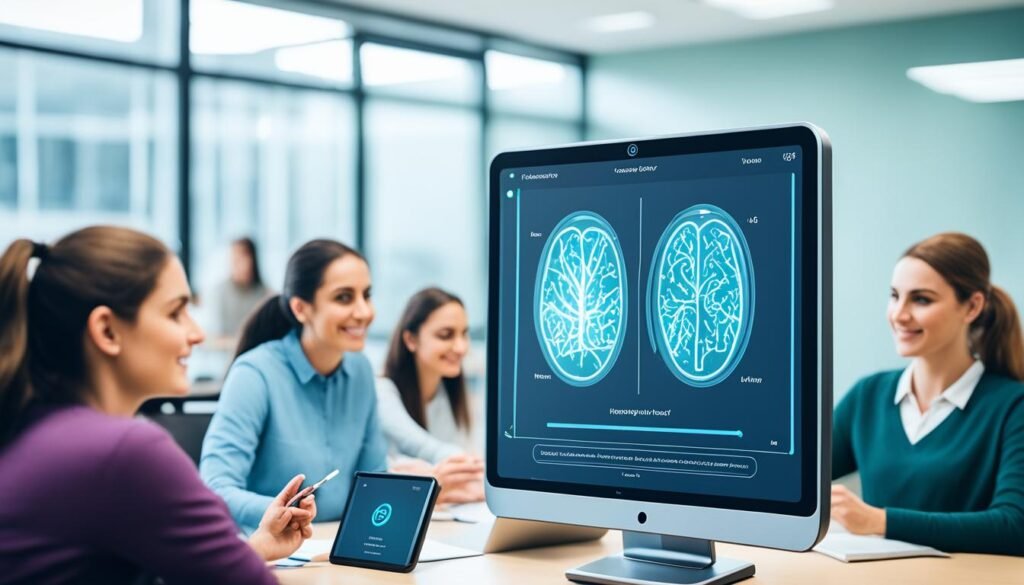Did you know AI tools can save teachers up to 20% of their time on grading and feedback tasks? This shows how AI can change education for the better. But, it also shows we must balance AI with human judgment. As an educator, knowing the ethical sides of AI in your classroom is key.
This guide will cover the main points of AI ethics in education. You’ll learn how to use AI practices responsibly for fair and effective learning. We’ll talk about the role of generative AI tools, the risks of algorithmic bias, and how to keep student data private. This will help you make your learning environment ethical AI-powered and supportive.
Key Takeaways
- AI tools can make learning more personalized and grading easier, but we must balance them with human insight.
- Teachers should watch out for biases in AI algorithms to avoid stereotypes and unfairness in the classroom.
- For ethical AI in schools, focus on transparency, keeping student data safe, ongoing learning, and teaching critical thinking.
- Teach students about AI ethics, privacy, and fairness to improve their digital smarts and understanding.
- Using AI responsibly in education means tackling issues like cheating and making sure all students have equal access.
Introduction to AI Ethics in Education
As AI gets more advanced, it’s key for teachers and students to understand its ethical sides. Using generative AI tools needs careful thought to make sure they help learning and keep things honest.
Importance of Familiarizing with Generative AI Tools
Getting to know generative AI tools is a must, whether you use them or not. These tools, like language models and content generators, are getting more common and easy for students to find. Knowing what they can and can’t do helps you see how they might change student learning and tests.
Learning about generative AI means looking at big ethical issues like privacy, equity, and bias. When you check out these tools, think about how they might change the classroom. You should also plan how to use them right and openly.
“The rise of generative AI tools in education has significant implications for both teaching and learning. Embracing these tools while maintaining academic integrity and ethical practices is a critical challenge facing educators today.”
By looking at generative AI tools with a critical and ethical view, you can make sure they fit your teaching goals. This keeps learning honest and open to everyone.
Ethical Considerations in Generative AI
Generative AI tools are becoming more common in education. It’s important to think about their design, development, and use. The ethics of generative AI, transparency in AI, and bias in AI are key topics for educators and policymakers. They need to make sure these tools are used responsibly and fairly.
The European Commission gave Ethical guidelines on the use of artificial intelligence (AI) and data in teaching and learning for educators in 2022. These guidelines cover important points like transparency, oversight, and how AI affects politics and the environment. They also talk about diversity, fairness, privacy, and data management. It’s vital to tackle these issues to use these technologies safely and ethically in schools.
Researchers have found that Large Language Models (LLMs) in generative AI might perpetuate inequities if not checked. It’s important to make AI transparent and test it for bias. This helps make sure these tools are used right.
There are also big legal concerns about using generative AI in education. The European Commission pointed this out in 2022. Educators and policymakers have to deal with these complex legal and ethical issues. They need to protect students’ rights and well-being.

As more schools use generative AI, they need to create strong policies and rules. This ensures these tools are used ethically and responsibly. By focusing on transparency, fairness, and privacy, we can use these technologies to their full potential.
Empowering AI Education in K-12
AI is changing fast, and teachers are finding new ways to use it in K-12 schools. AI can check how well students are doing quickly and accurately. This helps teachers see where students need help and change their teaching plans.
AI also makes learning personal by looking at what each student needs and how they’re doing. It changes lessons to fit each student’s learning style.
AI for Student Assessment and Personalization
More and more, AI is being used in K-12 schools. It’s expected to grow a lot, reaching $21.13 billion by 2028. But, teachers need to think about the right use of AI to avoid problems like privacy issues and unfairness.
The Kapor Center has a guide called “Responsible AI & Tech Justice: A Guide for K-12 Education.” It’s a 27-page guide written by experts. It gives teachers ways to check if AI tools are good for the classroom.
This guide talks about how to use AI safely and fairly. It suggests adding talks about ethics and fairness in AI lessons. It also has questions to help teachers discuss these topics.
Working with experts and following ethical rules can help teachers use AI well in K-12 schools. This way, students get lessons that fit them and fair tests. It also keeps their privacy and safety in mind.
ai ethics in education
As AI becomes more common in schools, we must think about its ethical sides. Tools like generative language models help students and teachers a lot. But, they also have risks we need to look at closely.
One big worry is AI might keep biases and unfairness going. The data these models learn from might show biases, making content that could make some students feel left out. Teachers should be careful with AI, checking if the content is fair and right for students.
Using AI in schools also brings up privacy issues. Schools must be clear about how they use student data with AI. They need to get permission and keep student info safe. Teachers must make sure AI use respects students’ privacy and follows data rules.
To tackle these issues, schools need strong rules for using AI right and fairly. This could mean training teachers on AI ethics. It also means setting up rules and checks to make sure AI is used well in class.
“The ethical use of AI in education is not just a nice-to-have, but a moral imperative. We must ensure that the benefits of these powerful technologies are equally accessible and that they do not perpetuate or exacerbate existing inequities.” – Dr. Mario Herane, Educational Technology Expert
By focusing on AI’s ethical side, we can make the most of these technologies. We can keep education fair, open, and caring for students. As AI use grows in schools, we must stay alert and act to solve ethical problems.

| Metric | Value |
|---|---|
| Accesses to the Article | 30,000 |
| Citations of the Article | 20 |
| Altmetric Score | 120 |
Preventing Academic Dishonesty with AI
Generative AI chatbots like ChatGPT are becoming more common, raising concerns about students cheating on assignments. But, just banning these tools won’t work. We need to teach students how to use AI right, like we teach safe driving.
Teaching Ethical AI Practices
It’s important to teach critical thinking and using AI as a tool, not a shortcut. We should also help students spot bias in AI and check its accuracy. Being open about AI use and knowing what cheating is helps too. Teaching students to be ethical online is key.
By teaching these skills, we can help students use AI without cheating. This keeps academic integrity in the age of AI strong.
- Encourage critical thinking: Teach students to question AI’s accuracy and think deeply about the info.
- Use AI as a tool, not a crutch: Show that AI should help, not replace, knowledge and ideas.
- Analyze bias in AI: Teach students about AI biases and how to spot them.
- Confirm accuracy: Tell students to check AI’s info against course goals and rules on honesty.
- Be transparent about AI use: Make students say when they used AI and give credit for AI-made content.
- Understand academic dishonesty: Define cheating and plagiarism with AI, and have clear rules for breaking them.
- Empower ethical digital citizens: Teach students to use technology, including AI, responsibly and ethically.
By teaching ethical AI practices, we prepare students for the AI era while keeping academic integrity strong. This stops AI-assisted cheating and makes sure students use AI wisely.
Equity and Bias in AI Education
As AI becomes more common in schools, we must tackle the biases it can bring. Tools like ChatGPT can help students catch up, but they might also spread old biases and stereotypes.
Not all students have the same access to advanced AI tools. This can make learning unfair. Teachers need to think about how this affects students and make sure everyone gets a fair chance to use these tools.
It’s important to be open about how AI systems work. Companies should share details about their data and how they made the AI. This helps teachers and leaders make smart choices about AI in the classroom.
Having a diverse team working on AI can also help fix bias issues. Experts from different backgrounds can create better ways to check if AI is fair in real-life situations, like schools.
| Metric | Percentage |
|---|---|
| Employees worried about AI making their job duties obsolete | About 50% |
| Employees worried about AI making their job duties obsolete and reporting negative impact on their mental health | About 50% |
| Employees not worried about AI making their job duties obsolete and reporting negative impact on their mental health | 29% |
To make AI in schools fair and right, teachers must act. They should work on being open, make the AI team more diverse, and teach students how to use AI wisely. This way, we can make sure all students have the same chance to learn.
“Artificial intelligence technologies can make learning more personal for students, but it’s key that everyone has the same access to them. Teaching students how to use AI is vital for fairness in education.”

Privacy and Data Governance in AI
Safeguarding Student Data
When students use AI systems, keeping their data private is key. Large language models can keep user chats and use them to learn, which means any info shared can be shared again without permission. Teachers must not share student info under FERPA or other laws. They should tell students to only share info they don’t mind everyone knowing.
Having good data rules for AI in schools is vital for keeping student data private. Companies using AI must handle privacy risks and follow the law, as privacy is seen as a basic right. If there’s a data breach, it can hurt trust, so strong privacy steps are key.
Using Data Protection Impact Assessments and Privacy by Design helps tackle AI privacy risks. Things like homomorphic encryption and anonymization make AI data safer. It’s also important to check data often and control who can see it to stop unauthorized access and keep data reliable.
| Key Considerations for Student Data Privacy and AI Data Governance |
|---|
|
Putting student data privacy and data rules for AI in schools first is crucial for trust and success. By tackling privacy risks and keeping data safe, schools can use AI’s benefits while protecting their students’ private info.
Responsible AI Use in Teaching and Learning
As responsible AI practices in education and ethical AI for teaching and learning grow in importance, educators must teach students how to use tools like ChatGPT wisely. The aim is to help students use AI’s benefits while keeping their work honest.
The Washington State AI Guidance has been adopted by Singapore American School (SAS) to create rules for using AI responsibly. SAS is making these rules fit their school’s needs. The rules say students must be open and truthful about using AI in their work.
Teachers at SAS will tell students if AI is okay to use and why. They will teach students how to use AI right, showing them how to check AI’s work and see it as a tool to help learning. Teachers will also help students learn about AI and how it’s used.
By teaching students to use ChatGPT right, we’re getting them ready for the ethical issues they’ll face with AI in their careers and lives. Some key tips include:
- Use real tasks and feedback that students care about.
- Break down writing tasks and projects into smaller steps.
- Change how writing tasks are given.
- Give regular feedback from teachers and peers.
- Use AI tools to help with tasks and projects.
- Let students show what they know in different ways, not just writing.
- Ask for lots of sources.
- Have students use resources AI can’t access.
We aim to help students be kind and considerate, even with ChatGPT by their side. By teaching them to use ChatGPT right, we empower them to enjoy AI’s perks while keeping their work honest.

“As we trust students to make the right decisions, they’ll learn how to use AI chatbots the right way, and their confidence and learning skills will grow.”
Future of AI in Education
Generative AI technologies like ChatGPT are changing education in big ways. They can make learning more personal, help with school tasks, and improve thinking skills. But, they also bring up ethical issues that need careful thought.
To help students use AI wisely, teachers must teach them about responsible AI use. By learning how to use tools like ChatGPT well, students can grow and learn better. This helps them think critically and solve problems in the changing world of education.
As we look ahead, schools are starting to teach AI ethics. This shows they’re aware of the risks of AI, like biased algorithms and privacy issues. By tackling these problems, schools can make sure students use AI in a smart and responsible way.
| Trend | Data Point |
|---|---|
| Integration of AI in the classroom | Increasing trend |
| Adoption of AI systems by educational institutions | Growing steadily |
| Concerns about data breach incidents impacting students | Real and consequential |
| Importance of protecting student data privacy | Critical |
| Strategies for safeguarding student data | Increasing emphasis on encryption and access control |
The future of AI in education is all about teaching ethics and protecting student data. By tackling these issues, educators can help the next generation use AI wisely. This will unlock the full potential of AI in education.
“The future of AI in education is not about replacing teachers, but about empowering them to deliver personalized, engaging, and effective learning experiences.”
Conclusion
Using AI in education needs careful thought and ethical steps. Educators should learn about AI tools and their ethical sides. This helps them use AI to make learning better, more personal, and fair. It also helps address issues like privacy, bias, and cheating.
As education changes, knowing about key takeaways on ai ethics in education is key. This knowledge helps make learning fair and effective for everyone. It’s as important as learning to read and do math.
There’s a big push for schools to teach AI ethics. This includes both technical skills and understanding the ethical sides of AI. It’s seen as vital, like learning math and English.
AI is changing how universities pick students. It’s important for schools to have clear AI rules. They must focus on privacy, getting consent, and how AI affects people and communities. By focusing on key takeaways on ai ethics in education, schools can prepare students for a future with AI. This way, students can use technology wisely and with integrity.
FAQ
What are the key principles of AI ethics in education?
Key principles include transparency and oversight, addressing political and environmental impacts. They also cover ensuring diversity, non-discrimination, and fairness. And, protecting student privacy and data governance.
Why is it important for instructors and students to understand generative AI tools?
Understanding generative AI tools is crucial for both instructors and students. It helps them decide if and how to use these tools in their work. Using a thoughtful, critical, and ethical approach is key to seeing their benefits and challenges.
How can educators encourage ethical and responsible use of generative AI in the classroom?
Educators can encourage ethical AI use by focusing on transparency, oversight, bias, and privacy. They can outline ways to use AI responsibly in the classroom.
How can AI be used to improve student assessment and personalization in the classroom?
AI can make assessments more accurate and timely. This helps teachers spot areas where students need help. It also lets teachers tailor lessons to each student’s needs by analyzing their learning data.
What are the potential challenges of using AI in the classroom, and how can educators address them?
Educators need to watch out for ethical issues and biases in AI use. They should protect student privacy and ensure fairness. Clear guidelines for assignments and grading help make learning fair for everyone.
How can educators teach students to use AI chatbots like ChatGPT ethically and responsibly?
Teaching students to use AI tools like ChatGPT responsibly is important. It’s like teaching safe driving habits. This includes critical thinking, using AI as a tool, and understanding bias. It also means being open about AI use and what cheating is.
How can educators address concerns about student privacy and data governance when using AI in the classroom?
Educators must protect student data by not sharing sensitive information. They should encourage students to share only what’s safe. Being open and responsible with student data is key when using AI in teaching.
